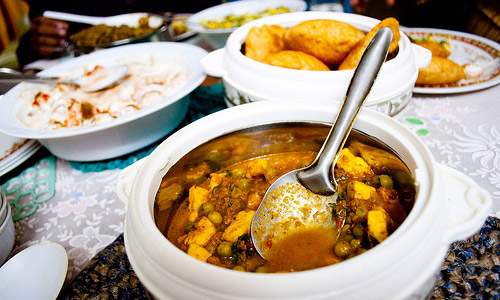Beginners Guide to Indian Food

If the picture you conjure up of India constitutes decorated elephants, cows on the road, slums, chicken tikka and a multitude of colors, then there is some serious image change that is needed. Today, India is one of the fastest growing economies in the world; everything from Indian fabric to intelligence is outsourced. Over the years, Indian food has become popular with more and more people discovering that there is more to it than just ‘naan’ (soft oven baked bread) and ‘chicken tikka’ (curry). The amalgamation of various flavors, the richness of color and the subtle spices make Indian food one of the most flavorful and robust cuisines of the world. Also the growing popularity of fusion food has given this cuisine the much need makeover, but nothing beats the authentic flavor of Indian food. Here is a crash course on Indian food – what to eat and what not to eat if you are a beginner.
1. Curry
The one word that represents India in the west is ‘curry’. Irrespective of its genesis, anything spicy, red in color and gravy type dish is called ‘curry’. The main flavoring that goes into a curry includes coriander, chili, turmeric, cumin, black pepper etc. There are five basis gravies that are made in India each having a distinct taste. The dishes are also heavily influenced by the region they come from. Something from the north east belt will be a tad spicy and mustard flavored, down south it will be mild and made mostly in coconut oil, curries from the north are rich, full bodied and made in clarified butter while western India lends a groundnut flavor to the gravy because of its extensive use in the region. If you are trying Indian food for the first time, go in for milder gravies like the ‘makhni’ or cream based dishes like ‘Malai Kofta’, ‘Kaju (Cashew) curry’, etc.
2. Dal
India makes the most use of all the lentils under the sun. Usually eaten as an accompaniment with rice or ‘roti’ (Indian bread), ‘Dal’ has come to become a staple in every household. Widely used lentils include green gram, black gram, split chickpea, red lentils, kidney beans, garbanzo beans among a lot others. Dal can be made as simple as possible and at the same time as rich as you want. The versatility of this ingredient has given birth to a number of Indian Dal varieties including ‘Tadka Dal’, ‘Maa ki Dal’, ‘Panchmel Dal’, ‘Sambar’, ‘Makhni Dal’ etc. Like curries, Dal too differs from region to region – extensive use of tamarind in the south has given birth to the world famous ‘Sambar’ (a spicy and tangy lentil soup), western India adds some sweetness to this preparation and the best and the richest of the dals come from northern India. Due to the weather conditions, dals are made with a lot of butter and cream to keep the body warm. When accompanied with some warm tandoori bread, this meal can give the best of the restaurants a run for their money.





